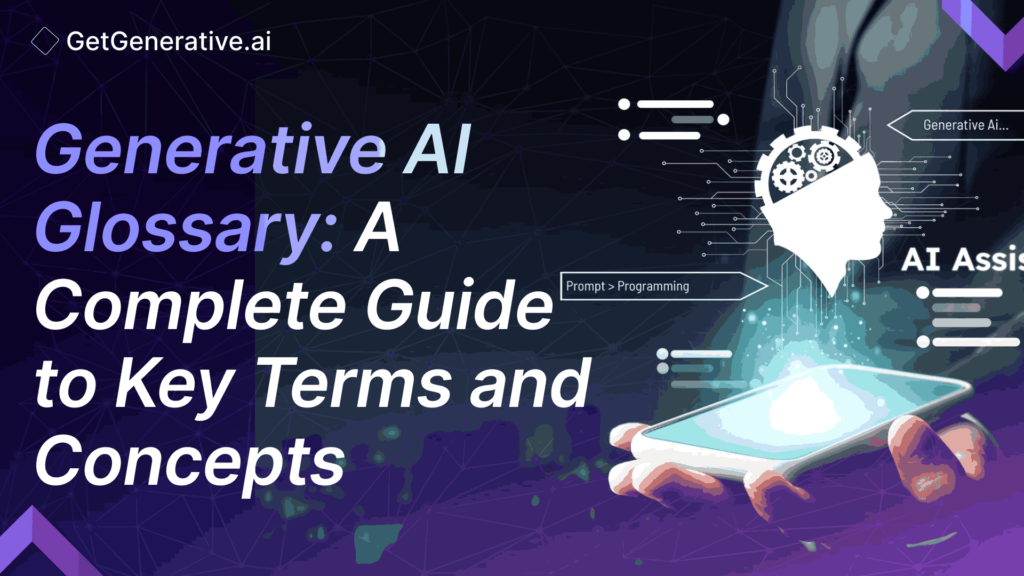Generative AI Glossary: A Complete Guide to Key Terms and Concepts
Generative AI is rapidly transforming industries ranging from creative arts to customer service, making it crucial for professionals and enthusiasts to understand its underlying concepts. As of 2023, the generative AI market is expected to grow annually by over 34%, reflecting its expanding role in business and technology.
This glossary demystifies terms related to generative AI, offering clear definitions and practical applications to help you navigate this innovative field effectively. By enhancing your knowledge with these key terms, you can better leverage AI technologies to drive innovation and efficiency in your endeavors.
1. Anthropomorphism
Anthropomorphism attributes human traits to AI systems, interpreting their outputs as if they have human emotions or intentions. While this makes AI interactions seem more natural, it’s crucial to remember that AI lacks consciousness.
2. Artificial Intelligence (AI)
AI encompasses technologies that emulate human intelligence and behavior. It enhances user experiences by automating tasks, making personalized recommendations, and facilitating efficient interactions.
3. Artificial Neural Networks (ANN)
ANNs are algorithms designed to recognize patterns by mimicking the brain’s structure. They are pivotal in making accurate predictions and personalizing user experiences, significantly enhancing customer satisfaction.
4. Augmented Intelligence
This concept combines human and machine intelligence to maximize data handling and decision-making capabilities. It leverages computational speed and human contextual understanding to improve outcomes in various applications.
5. Conversational AI
Conversational AI uses natural language processing to interact in human-like conversations, providing 24/7 customer support and enhancing user experience through more intuitive interactions.
6. CRM with Generative AI
Generative AI transforms CRM systems by automating content creation, such as personalized emails, and enhancing customer relationship management through tailored interactions and efficient service.
7. Deep Learning
Deep learning, a subset of machine learning, involves layered neural networks that help recognize complex patterns. This technology is essential in fields like image recognition and speech processing.
8. Discriminator in a GAN
In Generative Adversarial Networks (GANs), the discriminator assesses data authenticity, playing a crucial role in applications like fraud detection by distinguishing between real and synthetic data.
9. Ethical AI Maturity Model
This framework guides organizations in implementing responsible AI practices, focusing on transparency, fairness, and accountability to build trust and ensure ethical AI usage.
10. Explainable AI (XAI)
XAI aims to make AI decisions transparent, enabling users to understand and trust AI outputs crucial in sensitive applications like healthcare and finance.
11. Generative AI
Generative AI focuses on creating content or data based on existing patterns. It’s extensively used in marketing, e-commerce, and customer service to generate personalized content efficiently.
12. Generative Adversarial Network (GAN)
A GAN involves two neural networks, the generator and the discriminator, which work together to improve data authenticity, aiding in sophisticated marketing and data security.
13. Generative Pre-trained Transformer (GPT)
GPT models are advanced AI systems that generate human-like text, facilitating personalized customer interactions and content creation.
14. Grounding
Grounding ensures AI systems relate their responses to real-world knowledge, enhancing the relevance and accuracy of their outputs.
15. Hallucination
AI hallucination occurs when a model generates incorrect or irrelevant information, emphasizing the importance of monitoring AI outputs to maintain reliability.
16. Human in the Loop (HITL)
HITL involves human oversight in AI operations, ensuring AI outputs’ accuracy and ethical alignment and enhancing trust and system reliability.
17. Large Language Model (LLM)
LLMs process vast amounts of text to generate coherent and contextually appropriate responses, supporting tasks like customer service and content generation.
18. Machine Learning
Machine learning enables systems to learn and improve from experience without explicit programming, which is essential for predictive analytics and personalized services.
19. Machine Learning Bias
This refers to AI models developing biased outputs based on skewed data inputs, highlighting the need for diverse data and ongoing monitoring to ensure fairness.
20. Natural Language Processing (NLP)
NLP allows machines to understand and generate human language, facilitating more natural and effective communication with users.
21. Parameters
In AI, parameters are the configurations that guide model behavior, which are crucial for fine-tuning performance and ensuring the relevance of AI outputs.
22. Predictive AI
Predictive AI uses historical data to forecast future events, enabling personalized customer experiences and informed business decisions.
23. Prompt Defense
Prompt defense involves safeguarding AI models against generating harmful or biased outputs by setting strict guidelines on content generation.
24. Prompt Engineering
This involves designing inputs for AI systems to elicit the most accurate and relevant outputs, enhancing the effectiveness of AI interactions.
25. Red-Teaming
Red-teaming in AI involves challenging AI systems to identify vulnerabilities ensuring robustness and safety in AI applications.
26. Reinforcement Learning
This AI training method uses trial and error, rewarding correct outputs to refine AI behaviors, similar to training a pet with treats.
27. Safety
AI safety focuses on preventing unintended harmful consequences, ensuring that AI systems operate reliably and ethically.
28. Sentiment Analysis
This technique analyzes the emotional tone behind texts to understand user sentiments and is widely used in customer feedback and market analysis.
29. Supervised Learning
Supervised learning involves training AI with known data inputs and outputs, enhancing its ability to make accurate predictions.
30. Toxicity
AI toxicity refers to harmful or offensive outputs generated by AI, underscoring the importance of filtering and monitoring content to maintain respectful interactions.
31. Transformer
Transformers are advanced models that process data sequences, which is crucial for understanding the context in language processing and content generation.
32. Transparency
Transparency in AI involves being clear about how AI systems operate and use data, building user trust and understanding.
33. Unsupervised Learning
This learning type lets AI explore data without predefined labels, helping discover hidden patterns and insights crucial for personalized user experiences.
34. Validation
Validation tests AI models against unseen data to ensure they learn effectively, akin to conducting a pop quiz to assess knowledge retention.
35. Zero Data Retention
This practice involves not storing data used in AI interactions, ensuring user privacy and trust.
36. Zone of Proximal Development (ZPD)
In AI, ZPD involves training models on progressively challenging tasks to enhance their learning capabilities, improving their performance and adaptability.
Conclusion
Understanding these terms is crucial as generative AI continues to evolve and integrate into various sectors. This glossary enhances your conceptual knowledge and prepares you to leverage AI technologies effectively in your personal and professional endeavors.
Visit GetGenerative.ai to explore more about Salesforce and AI.
Frequently Asked Questions (FAQs)
1. What is the difference between AI and Generative AI?
AI refers to the broad capabilities of machines to mimic human intelligence. Generative AI specifically focuses on creating new content from learned data patterns.
2. How does deep learning differ from other AI techniques?
Deep learning uses layered neural networks to analyze data, making it particularly effective for processing complex patterns like speech or images.
3. What is the significance of ‘Human in the Loop’ in AI systems?
Human oversight ensures that AI systems are accurate, ethical, and aligned with organizational goals, enhancing reliability and trust.
4. Can AI systems be biased? How is this addressed?
AI systems can exhibit biases based on their training data. Addressing this requires using diverse data sets and continually monitoring and adjusting the AI’s learning process.
5. Why is transparency important in AI?
Transparency helps users understand how AI systems make decisions, which is essential for trust, especially in applications involving sensitive data or critical decisions.




